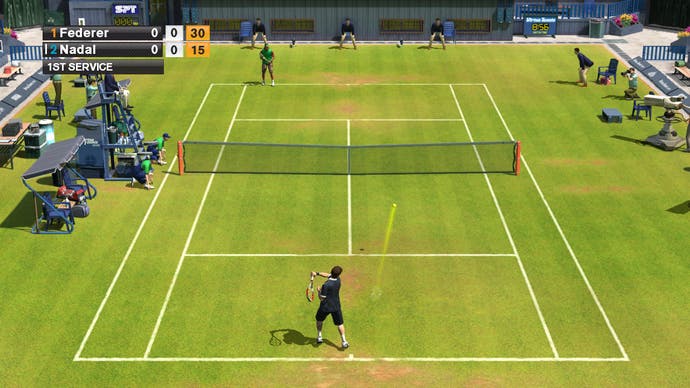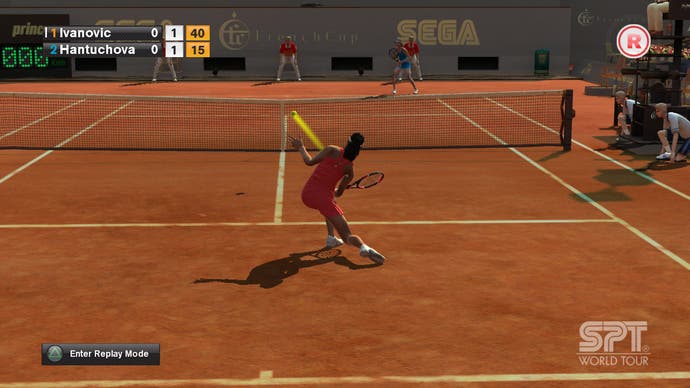Virtua Tennis 2009
New balls please.
Virtua Tennis has almost become a victim of its own success. By nailing the fundamentals with intuitive precision and peerless fluidity at the first attempt, subsequent improvements have been somewhat incremental. The 2001 sequel added female players and speeded up the gameplay a notch, while the third added long-awaited online play and sharpened up the already superb visuals. Apart from updating the roster and perhaps making the online mode a tad more expansive and flexible, there's not much else tennis fans could really want from a 'new' version.
Perhaps not calling this Virtua Tennis 4 is more significant than it initially appears, because what we're dealing with here is a refreshed VT3 rather than a true sequel. The clue is in the choice of developer, with series creator SEGA-AM3 (aka Hitmaker) taking a back seat to UK starlets Sumo Digital (responsible for the Xbox 360 and PSP ports of VT3, and, more recently, last year's SEGA Superstars Tennis). After seeing how well the Sheffield-based studio handled both of those, no one should worry about technical credentials, but alarm bells always ring when a new team takes over a beloved franchise. Does Sumo stay true to the feel, or does its fresh perspective tinker to a ruinous degree in a misguided search for progress?
Initial concerns are laid to rest the first time you pick the game up. Sumo definitely hasn't broken things that didn't need fixing. The overall feel is much the same as it's always been, which is to say instinctive, stripped-down and fluid. The controls work on pure timing, positioning and shot direction, with the choice of topspin, slice or lob shots mapped to the same buttons as ever (and with four configurations available, every preference is catered for).

Whether you fire in a forehand, backhand, drop shot, cross court or smash shot is a mixture of shot-selection and raw timing, mixed with the small matter of where you place your player at the point you decide to try and hit the ball. Set yourself early enough, and you'll have time to hit the ball at the peak of its bounce and therefore maximise the power on the shot. Leave it too late, and you'll either scuff the return weakly or end up stretching for the ball on the run - neither of which gives you optimum power, accuracy or direction. One difference is the way players no longer make ridiculous dives for the ball in the manner which blighted VT3 for a lot of players. Instead, players stretch in the manner they used to back in 1 and 2.
Unlike other tennis games, Virtua Tennis 2009 continues to stick by the series' 'no gimmicks' principle. That means no special power bars, turbo shots, morale meters, energy gauges or hand-crippling button combos. While you'll certainly see and feel when your player has hit the ball sweetly, and notice when your player is starting to tire, it's all pulled off with admirable subtlety. The only time you see a power bar is during the serve, and even that's slightly superfluous.
While the fundamentals remain largely familiar, Sumo has tried to freshen the game up elsewhere - most noticeably in the familiar, single-player only marathon World Tour, where you're tasked with building up your rookie from the lowly depths of rank 100 right the way up to the pinnacle. You work your way through a calendar year, entering tournaments, playing surreal court games, diving into the Tennis Academy and generally trying to both improve your rank and your player abilities.

Ranking up is simple - just enter the singles or doubles tournaments closest to your rank, and attempt to win them. What's not quite so straightforward is improving your abilities. While all previous Virtua Tennis games kept things nice and transparent, 2009's take has you choosing to play the court games or try and beat the numerous challenges housed in the Tennis Academy, and the net result is that you gradually fill up three sections of skill: Ground Strokes, Footwork & Technique, and Serve & Volley. Every time you fill one of these bars, you unlock a new play style, which you can then assign to your player. 23 are available in all, allowing you, for example, to become a Serve & Volley specialist or perhaps a fast runner or big server.
The problem with this system is that all it appears to do is allow you to hot-swap these styles between matches - both offline and on. In previous editions you were safe in the knowledge that your player character was slowly getting better in a variety of tangible ways, and the progress bars accurately reflected how good you could be. You knew that if you gradually levelled up your service or footwork, that there would be a measurable, quantifiable difference when it came to playing a match. The same just isn't true in VT2009, and as a result you never really feel like your player's properly progressing in the usual way.


